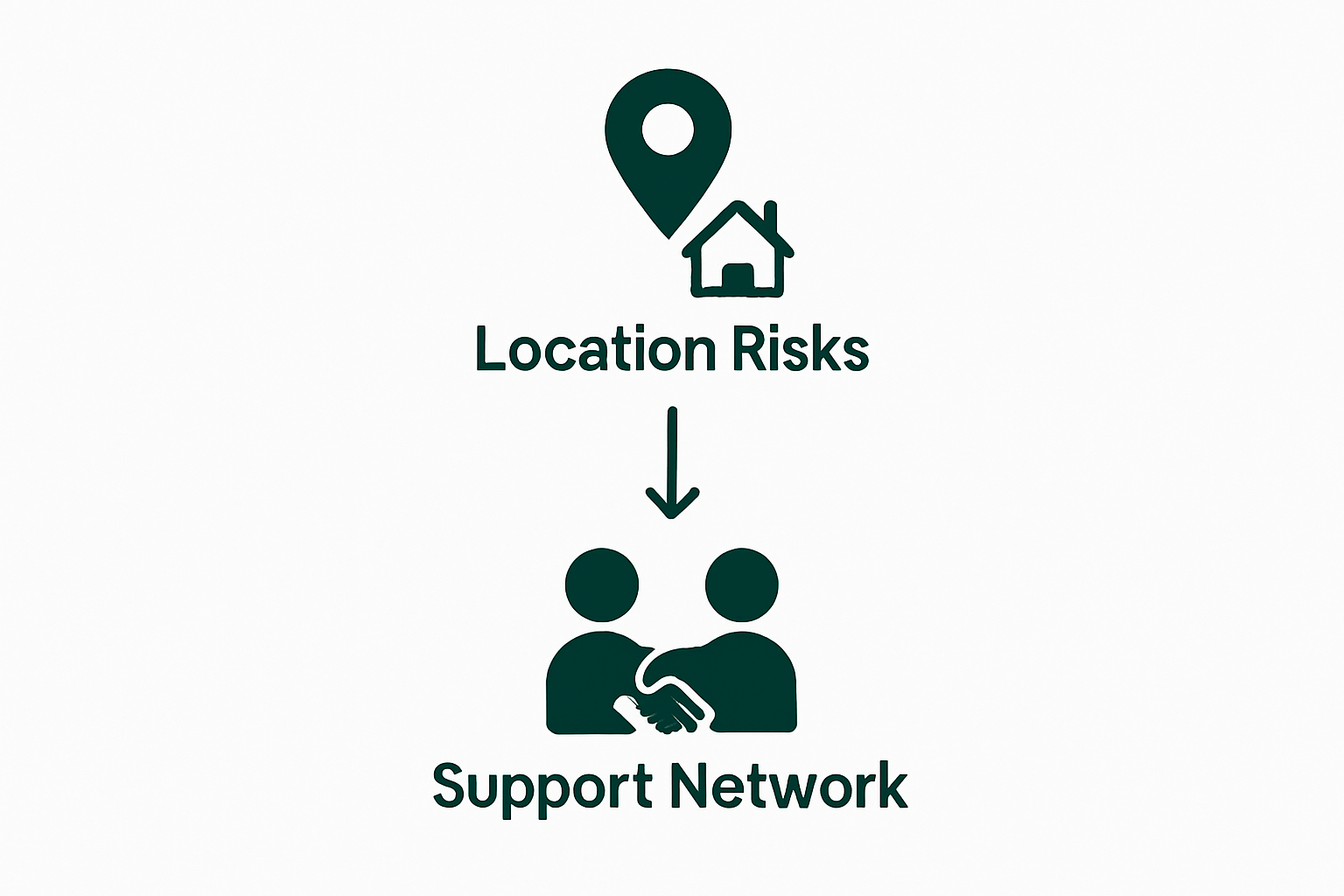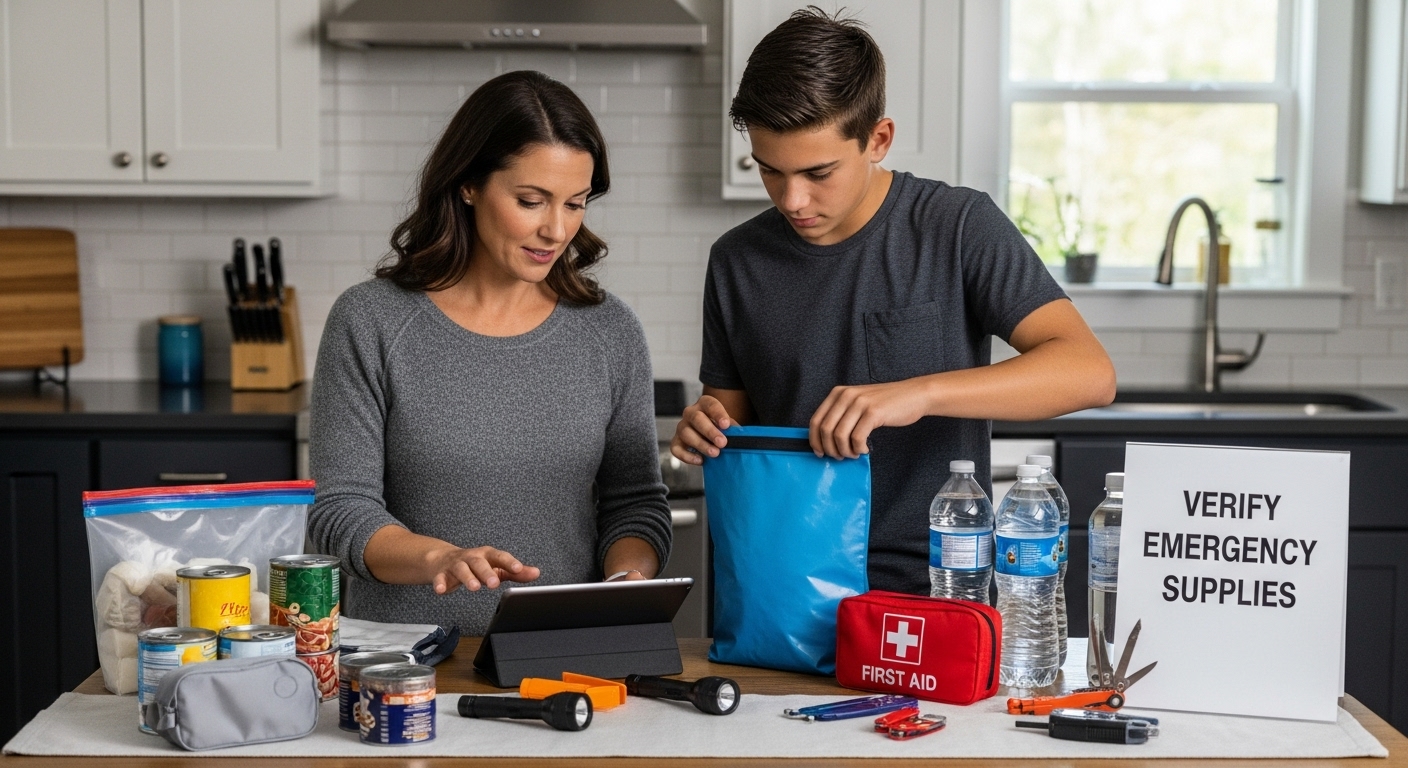Here in South Carolina, we’ve watched families scramble when hurricane warnings hit the coast. After decades of helping people move in and out of the Lowcountry, we’ve seen firsthand how quickly calm neighborhoods can turn into evacuation zones. While most folks rush to buy plywood and batteries once a storm appears on the radar, only 38 percent of Americans have a ready-to-go evacuation plan for hurricanes.
What catches families off guard isn’t just the storm itself, it’s realizing their evacuation strategy was built on hope rather than preparation. From our experience moving thousands of families through hurricane seasons, we know that the strongest evacuation plans aren’t thrown together in the 72 hours before landfall. They’re crafted during the quiet months, when you can think clearly about logistics, communication, and the hard decisions that come with leaving everything behind.
Table of Contents
Quick Summary
| Key Point | Explanation |
| 1. Understand Your Evacuation Zone | Identify if your area is in a hurricane evacuation zone to assess risks and needed preparations for safety. |
| 2. Build a Support Network | Connect with local emergency services and create a personal support system for effective communication and assistance during an evacuation. |
| 3. Create a Family Communication Plan | Develop a written evacuation plan that assigns roles and responsibilities to each family member for clarity and coordination during emergencies. |
| 4. Practice Evacuation Routes Together | Conduct regular evacuation drills to familiarize your family with multiple routes and respond efficiently under pressure. |
| 5. Maintain an Updated Emergency Kit | Create and routinely verify an emergency kit stocked with essential supplies and updated contact information for a swift response during an evacuation. |
Step 1: Evaluate Your Location and Needs
Creating an effective hurricane evacuation plan starts with a critical foundation: understanding your specific location and potential risks. This initial step determines how vulnerable you are and what precise preparations you’ll need to make for your family’s safety.
Begin by mapping out your immediate environment. Pull up online resources from your local emergency management office or county website to identify whether you live in a designated hurricane evacuation zone. These zones are predetermined areas most at risk during severe storms, typically based on proximity to coastal regions, low-lying areas, or flood-prone landscapes.
According to Ready.gov, residents should conduct a comprehensive risk assessment that goes beyond simple geographic location. This means examining your home’s structural integrity, understanding potential flood levels, and recognizing how wind patterns might impact your specific property. Pay close attention to details like your home’s elevation, surrounding terrain, and proximity to water sources.
Contact your local emergency management office to obtain detailed evacuation route maps specific to your neighborhood. These routes are strategically planned to move residents away from high-risk areas efficiently. Understanding these routes in advance means you won’t waste critical time figuring out an escape path during an actual emergency.
Key verification steps for completing this evaluation include:
-
Confirming your exact evacuation zone designation
-
Identifying primary and secondary evacuation routes
-
Understanding your home’s specific vulnerabilities
-
Documenting potential flood levels near your property
Remember that hurricane preparedness is not a one-size-fits-all approach. Your unique location demands a personalized strategy. Take time to research historical storm data for your specific area, which can provide insights into potential risks and help you make more informed decisions about your evacuation planning.

By thoroughly understanding your location’s specific challenges, you’re laying the groundwork for a robust and effective hurricane evacuation plan that could ultimately save lives.
Step 2: Identify Available Resources and Support
Once you understand your location’s risks, the next critical phase in hurricane evacuation planning involves identifying the resources and support systems available to you and your family. This step transforms your initial risk assessment into a practical, actionable strategy that maximizes your safety and preparedness.
Start by connecting with your local emergency management office. These professionals are your primary source of comprehensive information about hurricane evacuation procedures, shelter locations, and transportation assistance. Many counties offer special transportation services for residents with mobility challenges, seniors, or individuals without personal vehicles. Contact them early to understand the full range of support options specific to your community.
According to Ready.gov, developing a robust support network is crucial. This means not just relying on official resources, but also creating a personal support system. Reach out to family members, neighbors, and friends who can serve as emergency contacts or potential evacuation partners. Establish clear communication protocols for scenarios where cell networks might be compromised during a hurricane.
Financial preparation is another key aspect of resource identification. Ensure you have emergency funds accessible, preferably in cash, as banking systems could be disrupted during severe weather events. Consider setting up an emergency fund that covers potential evacuation expenses, including transportation, temporary housing, and essential supplies.
Key resources to document and verify include:
-
Local emergency management contact numbers
-
Designated community evacuation shelters
-
Special needs transportation services
-
Family and neighborhood emergency contacts
-
Nearby medical facilities that remain operational during emergencies
Technology can also play a significant role in resource identification. Download local emergency management apps, sign up for community alert systems, and follow official social media channels that provide real-time updates during hurricane events. These digital resources can provide critical information about evacuation routes, shelter availability, and emergency instructions.
Remember that identifying resources is an ongoing process. Review and update your support network and available resources annually, ensuring your hurricane evacuation plan remains current and comprehensive. By proactively building a strong support system, you’re creating a safety net that can make all the difference during a potentially life-threatening hurricane scenario.
Step 3: Create a Comprehensive Evacuation Plan
With your location risks assessed and resources identified, it’s time to craft a detailed and dynamic hurricane evacuation plan that covers every potential scenario. This step transforms your preliminary research into a concrete strategy that can protect your family during a potentially life-threatening emergency.
Begin by developing a family communication protocol that ensures everyone knows exactly what to do when evacuation becomes necessary. This means creating a written document that outlines specific roles, meeting points, and communication methods. Assign clear responsibilities to each family member, considering factors like age, mobility, and individual capabilities. For families with children, elderly members, or individuals with special needs, these assignments become even more critical.
According to National Academies of Sciences, comprehensive evacuation planning requires considering multiple potential scenarios. Map out at least three different evacuation routes from your home, understanding that your primary route might become blocked or unsafe during a hurricane. Practice these routes with your family, ensuring everyone understands alternative paths and potential challenges they might encounter.
Your evacuation plan should include a detailed emergency kit that can sustain your family for at least 72 hours. This kit goes beyond basic supplies, incorporating medications, important documents, communication devices, and specific needs for children, pets, or family members with medical requirements. Store this kit in an easily accessible location and ensure all family members know its exact location.
Key components to verify in your comprehensive evacuation plan include:
-
Documented communication protocol with family members
-
Multiple evacuation routes mapped and practiced
-
Emergency kit with 72-hour survival supplies
-
Designated out-of-area emergency contact
-
Copies of critical documents secured and portable
Technology can significantly enhance your evacuation plan. Use smartphone apps that provide real-time hurricane tracking, emergency alerts, and communication tools. Create digital backups of important documents and establish cloud-based communication methods that can work even if local cellular networks become overwhelmed.
Remember that a comprehensive evacuation plan is not a static document but a living strategy. Review and update your plan annually, conducting family drills to ensure everyone remains familiar with the protocols. By creating a thorough, adaptable plan, you’re giving your family the best possible chance of staying safe during a hurricane emergency.
Step 4: Communicate the Plan with Affected Parties
Effective hurricane evacuation planning extends far beyond personal preparation. The success of your strategy hinges on clear, comprehensive communication with everyone who might be impacted by your plan. This step transforms your individual strategy into a collaborative safety network that can protect not just your family, but potentially your entire community.
Start by having in-depth conversations with immediate family members, ensuring everyone understands their specific roles and responsibilities during an evacuation. Walkthrough the plan together, using visual aids like printed route maps and emergency contact lists. For families with children or elderly members, practice explaining the plan in age-appropriate, calm language that reduces potential anxiety while maintaining clarity about the seriousness of hurricane preparedness.
According to Ready.gov, communication should extend beyond your immediate household. Reach out to neighbors, especially those who might need additional assistance during an evacuation. This could include elderly residents, individuals with mobility challenges, or families with young children. Creating a neighborhood support network can make a significant difference in collective emergency preparedness.
Technology offers multiple communication channels to ensure your evacuation plan reaches everyone. Use group messaging apps, create shared digital documents, and establish backup communication methods like two-way radios or predetermined meeting points. Consider creating a neighborhood group chat specifically for emergency coordination, which can help disseminate critical information quickly during a hurricane event.
Key communication verification steps include:
-
Confirming all family members understand their evacuation roles
-
Sharing evacuation plans with immediate neighbors
-
Establishing multiple communication channels
-
Creating a written document everyone can reference
-
Practicing plan walkthrough with all affected parties
Pay special attention to communication strategies for family members with unique needs. This might mean creating special instruction cards for children, preparing visual guides for individuals with hearing impairments, or developing multilingual communication resources that ensure everyone can understand critical safety instructions.
Remember that communication is a two-way process. Encourage feedback from family members and neighbors, and be open to refining your plan based on collective input. By treating your hurricane evacuation plan as a collaborative effort, you’re building a resilient, supportive network that can effectively respond to potential emergencies.
Step 5: Practice and Revise Your Evacuation Plan
A hurricane evacuation plan is only as effective as its ability to be implemented under pressure. This final step transforms your carefully crafted strategy from a theoretical document into a reliable, actionable protocol that can protect your family during a real emergency. Consistent practice and periodic revision are the keys to maintaining an effective evacuation plan.
Begin by scheduling quarterly family evacuation drills that simulate different hurricane scenarios. These practice sessions should feel like a serious yet controlled exercise, not a frightening experience. Start with a calm walkthrough of your evacuation routes, emergency kit locations, and communication protocols. Gradually increase the complexity of your drills, introducing simulated challenges like blocked roads, communication disruptions, or separated family members.
According to OSHA, regular plan revision is crucial for maintaining effectiveness. Set a specific date each year to comprehensively review and update your evacuation strategy. This annual review should include checking emergency contact information, updating medical details, reviewing evacuation routes for any changes, and ensuring your emergency kit remains current and fully stocked.
Technology can enhance your practice sessions. Use smartphone GPS tracking during drills to verify route efficiency, time your evacuation procedures, and identify potential bottlenecks. Record these practice sessions to review and improve your family’s response time and coordination. Create digital checklists that family members can access quickly during an actual emergency.
Key verification steps for practicing your evacuation plan include:
-
Conducting full family evacuation drills at least twice annually
-
Timing and documenting evacuation procedure efficiency
-
Updating emergency contact and medical information
-
Checking and refreshing emergency supply kits
-
Reviewing and adjusting evacuation routes
Pay special attention to how different family members respond during practice. Young children might need additional support and explanation, while elderly family members might require specific accommodation strategies. Use these practice sessions as opportunities to build confidence and reduce potential anxiety about emergency scenarios.
Remember that an evacuation plan is a living document. Treat it as something that evolves with your family’s changing needs, local infrastructure modifications, and lessons learned from each practice session. By maintaining a dynamic, practiced approach to hurricane preparedness, you’re not just creating a plan – you’re building a comprehensive family safety strategy.
Step 6: Verify Emergency Supplies and Contact Information
The final layer of hurricane evacuation preparedness revolves around meticulously verifying your emergency supplies and maintaining updated contact information. This critical step transforms your theoretical plan into a tangible, ready-to-deploy safety strategy that can mean the difference between vulnerability and resilience during a hurricane emergency.
Start by creating a comprehensive emergency kit that goes beyond basic survival supplies. This kit should be portable, easily accessible, and packed in waterproof containers that can be quickly grabbed during an evacuation. Focus on creating a multi-purpose collection of items that address medical needs, communication requirements, and basic survival essentials. Consider the unique needs of each family member, including medications, personal documents, communication devices, and comfort items for children or elderly family members.
According to North Baptist Theological Seminary’s Hurricane Information Guide, your emergency supplies should include provisions for at least one week, covering food, water, medical needs, and critical documentation. Rotate perishable items regularly and maintain a digital and physical backup of important documents like identification, insurance papers, medical records, and emergency contact information.
Contact information verification requires a multilayered approach. Create a physical document with emergency contacts, medical information, and critical phone numbers that can be stored in your emergency kit. Simultaneously, establish digital backup systems using cloud storage or encrypted digital platforms that family members can access from multiple devices. Ensure that out-of-state contacts are included, as local communication networks might be compromised during a hurricane.
Key verification steps for emergency supplies include:
-
Checking expiration dates on all stored food and medical supplies
-
Verifying digital and physical copies of critical documents
-
Testing communication devices and backup power sources
-
Updating emergency contact information annually
-
Ensuring medical information is current and accessible
Technology can significantly enhance your emergency preparedness. Use smartphone apps that provide offline maps, emergency information storage, and communication backup. Consider investing in portable chargers, solar-powered devices, and redundant communication methods that can function when traditional networks fail.
Remember that emergency preparedness is an ongoing process. Schedule biannual reviews of your emergency supplies and contact information, treating this verification as a critical maintenance task.
Below is a checklist table to help you verify your emergency supplies and contact information, ensuring your family is always prepared for a hurricane evacuation.
| Verification Task | Purpose | Frequency |
| Check food and medical supply expiration dates | Ensure all items are safe and usable | Biannually |
| Verify digital and physical copies of documents | Guarantee quick access to essential information | Biannually |
| Test communication devices and backup power | Confirm reliable contact during emergencies | Biannually |
| Update emergency contact information | Maintain accurate and current contact lists | Annually |
| Ensure medical information is current | Provide up-to-date details for emergencies | Annually |
| Rotate perishable emergency kit items | Keep supplies fresh and ready | Biannually |
| Backup documents to digital/cloud storage | Secure critical paperwork for safe retrieval | Biannually |

Protect What Matters Most With Trusted Local Storage Solutions
You have spent time crafting your hurricane evacuation plan, making sure every step is clear and your family is protected. But as outlined in the article, a major pain point remains: how will you keep your belongings safe before, during, or after a storm? Flooding, wind damage, and rushed evacuations can put your most valued items at risk. Emergency situations demand flexible, weather-resistant storage you can trust, and peace of mind that your evacuation plan covers not just your family, but everything that makes your house a home.

Now is the time to bridge the gap in your hurricane preparedness. With Stomo’s portable storage solutions, you can secure your important possessions in a sturdy, weather-resistant container delivered right to your driveway in Charleston, Myrtle Beach, Columbia, and beyond. Our family-owned local team offers urgent delivery, flat-rate pricing, and a quick response when it matters most. Let us be part of your hurricane plan today. Visit https://stomostorage.com to request your tailored emergency storage solution and feel confident you are ready for whatever the season brings.
Frequently Asked Questions
What should be included in a hurricane evacuation kit?
Your hurricane evacuation kit should include supplies to sustain your family for at least 72 hours, such as food, water, medications, important documents, communication devices, and specific needs for children and pets.
How can I determine if I live in a hurricane evacuation zone?
You can determine if you live in a hurricane evacuation zone by visiting your local emergency management office’s website or contacting them directly. They provide maps and information about designated evacuation zones in your area.
What steps should I take to improve my home’s preparedness for hurricanes?
To improve your home’s preparedness, evaluate your home’s structural integrity, understand local flood levels, and secure heavy items that could become projectiles in high winds. Additionally, consider further reinforcing windows and doors.
How often should I practice my hurricane evacuation plan?
You should practice your hurricane evacuation plan at least twice a year. Conducting regular drills helps ensure all family members are familiar with the procedures and can execute them confidently during an actual emergency.
